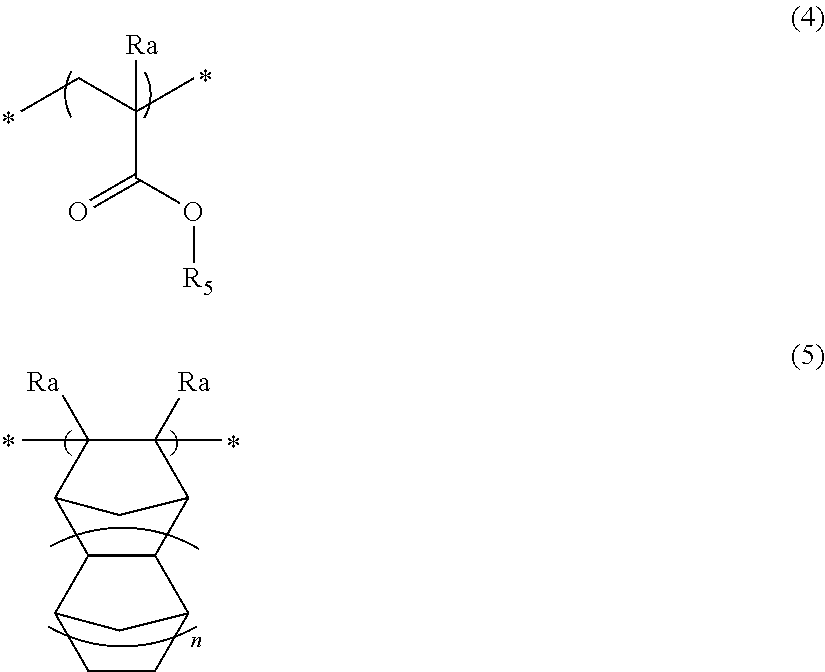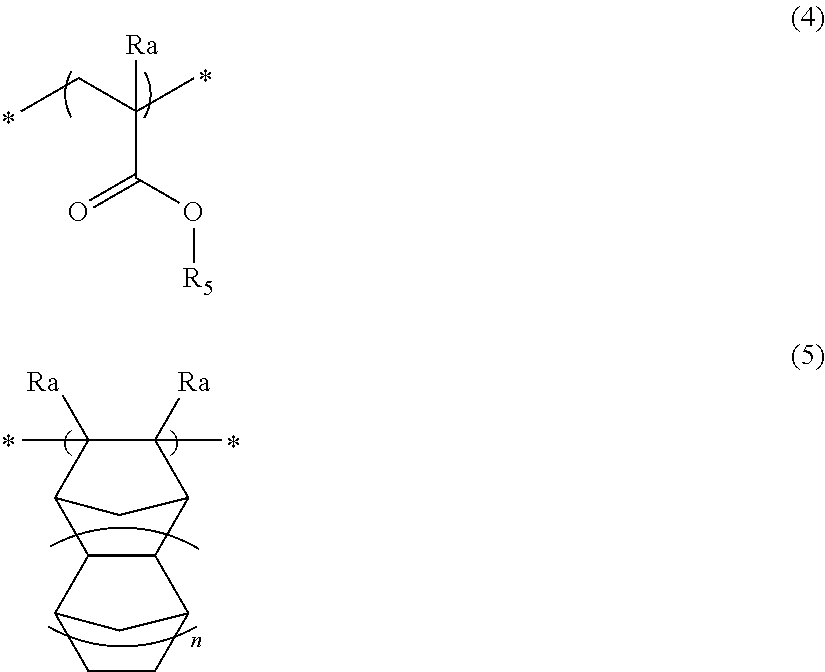Pattern forming method, chemical amplification resist composition and resist film
- Summary
- Abstract
- Description
- Claims
- Application Information
AI Technical Summary
Benefits of technology
Problems solved by technology
Method used
Image
Examples
synthesis example 1
Synthesis of Resin (A)
[0700]In a nitrogen stream, a three-neck flask was charged with 40 g of a 6 / 4 (by mass) mixed solvent of propylene glycol monomethyl ether acetate and propylene glycol monomethyl ether and heated at 80° C. (Solvent 1). Monomers corresponding to the following repeating units were dissolved at a molar ratio of 40 / 50 / 10 in a 6 / 4 (by mass) mixed solvent of propylene glycol monomethyl ether acetate and propylene glycol monomethyl ether to prepare a 22 mass % monomer solution (400 g), and polymerization initiator V-601 (produced by Wako Pure Chemical Industries, Ltd.) in a concentration of 8 mol % based on the monomers was added thereto and dissolved. The resulting solution was added dropwise to Solvent 1 over 6 hours. After the completion of dropwise addition, the reaction was further allowed to proceed at 80° C. for 2 hours. The resulting reaction solution was left standing to cool and then poured in 3,600 ml of hexane / 400 ml of ethyl acetate, and the powder precip...
synthesis example 2
Synthesis of Hydrophobic Resin
Synthesis of Monomer (4):
[0701]Compound (1) was synthesized by the method described in International Publication No. 07 / 037,213, pamphlet.
[0702]Water (150.00 g) was added to 35.00 g of Compound (1), and 27.30 g of sodium hydroxide was further added. The mixture was stirred for 9 hours under heating and refluxing conditions. The resulting reaction solution was rendered acidic by adding hydrochloric acid and then extracted with ethyl acetate. The organic layers were combined and concentrated to obtain 36.90 g of Compound (2) (yield: 93%).
[0703]1H-NMR (400 MHz in (CD3)2CO): σ (ppm)=1.56-1.59 (1H), 1.68-1.72 (1H), 2.13-2.1.5 (1H), 2.13-2.47 (2H), 3.49-3.51 (1H), 3.68 (1H), 4.45-4.46 (1H).
[0704]Subsequently, 200 ml of CHCl3 was added to 20.00 g of Compound (2), and 50.90 g of 1,1,1,3,3,3-hexafluoroisopropyl alcohol and 30.00 g of 4-dimethylaminopyridine were further added, followed by stirring. To the resulting solution, 22.00 g of 1-ethyl-3-(3-dimethylamino...
synthesis example 3
Synthesis of Acid Generator
Compound (PAG-1):
[0713]Triphenylsulfonium iodide (5.07 g (13 mmol), 2.25 g (13.5 mmol) of silver acetate, 120 mL of acetonitrile and 60 mL of water were added, and the mixture was stirred at room temperature for 1 hour. The reaction solution was filtered to obtain a triphenylsulfonium acetate solution.
[0714]In a nitrogen stream, 28.0 g (88.55 mmol) of 1,1,2,2,3,3-hexafluoropropane-1,3-disulfonyl difluoride, 17.92 g (177.1 mmol) of triethylamine and 210 mL of diisopropyl ether were cooled with ice, and a mixed solution containing 7.56 g (88.2 mmol) of piperidine and 105 mL of diisopropyl ether was added dropwise thereto over 30 minutes. This mixture was stirred for 1 hour under cooling with ice and further stirred at room temperature for 1 hour. The organic layer was washed sequentially with water, with an aqueous saturated ammonium chloride solution and with water, and the resulting organic layer was dried over sodium sulfate. The solvent was removed, and ...
PUM
| Property | Measurement | Unit |
|---|---|---|
| Percent by mass | aaaaa | aaaaa |
| Temperature | aaaaa | aaaaa |
| Temperature | aaaaa | aaaaa |
Abstract
Description
Claims
Application Information
 Login to View More
Login to View More - Generate Ideas
- Intellectual Property
- Life Sciences
- Materials
- Tech Scout
- Unparalleled Data Quality
- Higher Quality Content
- 60% Fewer Hallucinations
Browse by: Latest US Patents, China's latest patents, Technical Efficacy Thesaurus, Application Domain, Technology Topic, Popular Technical Reports.
© 2025 PatSnap. All rights reserved.Legal|Privacy policy|Modern Slavery Act Transparency Statement|Sitemap|About US| Contact US: help@patsnap.com



